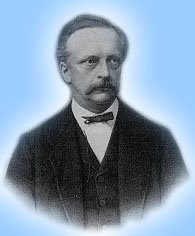

|
Reichenbach
on Helmholtz
|
 |
Reichenbach on Helmholtz
Reichenbach is by far the most important figure among the logical empiricists, when it comes to the philosophy of physics, and the philosophy of space and time, in particular. He acknowledges several precursors for their contributions to the clarification of logical and epistemological issues in the philosophy of space and time; and he gives a high opinion of Hermann Helmholtz (1821-94), in addition to Riemann (1826-66) and Poincare (1854-1912). Since Helmholtz's works on the philosophy of space and time are relatively unknown, it may be useful to show some extracts from Reichenbach's writings.
First, in Reichenbach's Philosophy of Space and Time (1958, German original 1928), he refers to Helmholtz as follows:
This conception of the problem of geometry is essentially the result of the work of Riemann, Helmholtz, and Poincare and is known as conventionalism. While Riemann prepared the way for an application of geometry to physical reality by his mathematical formulation of the concept of space, Helmholtz laid the philosophical foundations. In particular, he recognized the connection of the problem of geometry with that of rigid bodies and interpreted correctly the possibility of a visual representation of non-Euclidean spaces .... It is his merit, furthermore, to have clearly stated that Kant's theory of space is untenable in view of recent mathematical developments. Helmholtz' epistemological lectures must therefore be regarded as the source of modern philosophical knowledge of space. (35-6)
In this passage, the significance of "rigid bodies" is not adequately stated; so that it may be hard to understand Helmholtz's contribution in this regard. However, we can find another passage in Reichenbach's contribution to the Einstein volume of the Library of Living Philosophers (Schilpp 1949).
But the man to whom we owe the philosophical clarification of the problem of geometry is Helmholtz. He saw that physical geometry is dependent on the definition of congruence by means of the solid body and thus arrived at a clear statement of the nature of physical geometry, superior in logical insight to Poincare's conventionalism developed several decades later. It was Helmholtz, too, who clarified the problem of a visual presentation of non-Euclidean geometry by the discovery that visualization is a fruit of experiences with solid bodies and light-rays. We find in Helmholtz' writings the famous statement that imagining something visually means depicting the series of sense perceptions which one would have if one lived in such a world. ("The Philosophical Significance of the Theory of Relativity", 300.)
Again, as regards visualization, Reichenbach adds the following comment too:
Helmholtz was the first to advocate the idea that human beings, living in a non-Euclidean world, would develop an ability of visualization which would make them regard the laws of non-Euclidean geometry as necessary and self-evident, in the same fashion as the laws of Euclidean geometry appear self-evident to us. (308)
From these passages one can see that the two major contributions are attributed to Helmholtz by Reichenbach: (1) Helmholtz pointed out the need for the definition of congruence (what Reichenbach called "coordinative definition") in terms of solid (or rigid) bodies, when we speak of physical geometry; (2) Helmholtz clarified the nature of "visualization" of geometry (Euclidean as well as non-Euclidean) in terms of a series of possible perceptual experience with solid bodies and light-rays. Reichenbach himself utilizes these insights, criticizes Poincare and Einstein, and forms his own epistemology of physical geometry.
Å@
References
Reichenbach, H. (1958) The Philosophy of Space and Time, Dover.
Reichenbach, H. (1949) "The Philosophical Significance of the Theory of Relativity", in Albert Einstein: Philosopher-Scientist, ed. by P. A. Schilpp, Tudor.
Helmholtz' papers are available in English translation: Epistemological writings : the Paul Hertz/Moritz Schlick centenary edition of 1921 with notes and commentary by the editors / Hermann von Helmholtz ; newly translated by Malcolm F. Lowe ; edited, with an introduction and bibliography, by Robert S. Cohen and Yehuda Elkana, Reidel 1977.
Last modified March 31, 2003. (c) Soshichi Uchii